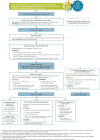Standards of Medical Care in Diabetes-2020 Abridged for Primary Care Providers
- PMID: 31975748
- PMCID: PMC6969656
- DOI: 10.2337/cd20-as01
Standards of Medical Care in Diabetes-2020 Abridged for Primary Care Providers
Figures







LinkOut - more resources
Full Text Sources
Other Literature Sources

